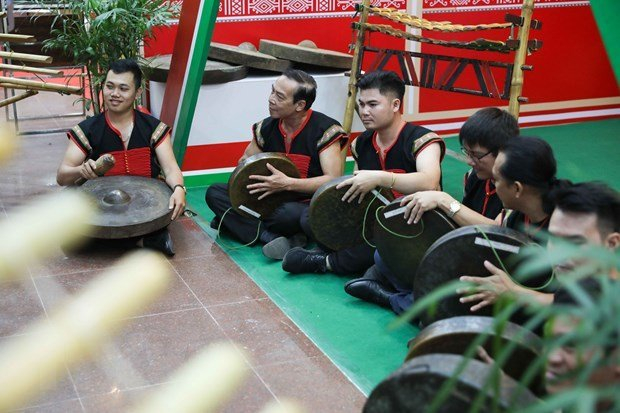Specific values of the cultural space of the Central Highlands gong are part of Vietnam’s cultural heritage and quintessence.
The cultural space of the Gongs in the central highlands of Vietnam covers several provinces and nearly seventeen ethnic groups belonging to the Austro-Asian and Austronesian linguistic groups. These populations live of traditional agriculture and have developed their own craft traditions, decorative styles and types of dwelling.
However, different ethnic minority groups arrange different orchestras. Listening to the sound of the gong, people in the Central Highland can know which ethnic group is playing.
Gong players in the majority of ethnic groups in the Central Highlands are male. Only in a minority of ethnic groups in the region, gong players are female.
The most outstanding value of gong culture showcases masterpieces of human creativity. The masters of gong culture are the ethnic people of the Central Highlands. Although they can not cast gongs themselves, they raise the value of a product into an excellent musical instrument with their sensitive ears and musical soul. In the hands of talented folk artistants, each gong plays the role of a musical note in an orchestra to perform different pieces of gong music.
As for ethnic minorities in the Central Highlands, gongs and gong culture present a means to affirm the community and its cultural identities. As time went by, gongs have become an attractive and appealing symbol of the culture of the Central Highlands. It is an activity associated with cultural and spiritual life, and beliefs of ethnic people when they are born, grown up and return to the soil.
The Central Highlands gong comes from long-standing historical and cultural traditions. In the past, community of people in the Central Highlands knew how to play the gong. Its sound is either deep or strong, moving and combining with the sounds of streams, wind and the hearts of people so that it can live with the heaven, the earth and people in the Central Highlands.
Every family possesses at least one gong, which indicates the family’s wealth, authority and prestige, and also ensures their protection. While a range of brass instruments is used in the various ceremonies, the gong alone is present in all the rituals of community life and is the main ceremonial instrument.
Caption of Gongs
Throughout the Central Highlands of Vietnam, Gong ensembles are parts of various ceremonies and closely linked to the communities’ daily life and the cycle of the seasons. The instruments, measuring 25 to 80 centimetres, are played by men as well as women.
The culture space of the Gongs is about original musical forms, which are performed against the background of the linguistic and ethnic diversity of the region. Diversity is also found in the compositions and customs of the Gong ensembles, in their performance techniques, in the musical genres and in the ritual functions of the gongs.
In the realm of Vietnam’s musical instruments, the gongs are very well-known for their outstanding value and regarded as the privileged language bridging humanity and the supernatural world. The gongs are made from a mixture of bronze and silver, with some distinctive features. The peoples living in the Central Highlands of Vietnam possess many sets of gongs, which would be performed differently. A set of gongs consists of two to twenty units.
Gong culture is said to originate in the ancient Dong Son civilization, also known as the brass drum culture, of Southeast Asia. The gongs of Vietnam are distinguished by the way they are played. Each instrumentalist carries a different drum of between 25 and 80 cm in diameter.
The groups of men or women are formed of between three and twelve gongs depending on the village. Different arrangements and rhythms are adapted to the context of the ceremony, for example, the ritual sacrifice of the bullocks, the blessing of the rice, mourning rites and harvest celebrations.
(news.chinhphu.vn)






